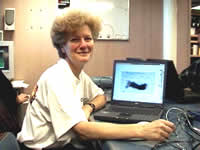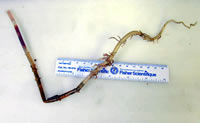|
Participant Perspective - July
30, 2001
 Interview
with Verena Tunnicliffe Interview
with Verena Tunnicliffe
Marine Biologist - University of Victoria
Jeff
G: Do the tubeworms eat their symbiotic bacteria or just absorb
their byproducts?
Verena:
It turns out that bacteria are notoriously leaky cells. We don't know
whether or not tubeworms induce the bacteria to leak products out, if
it just naturally happens, or if the worm is actually digesting some of
the bacteria. We don't actually see a lot of digestive processes going
on in the worms. It's probable that there's just a transfer of organic
matter through the cell wall. This is similar to corals and their symbionts.
Jeff:
How do the tubeworms acquire their symbiotic bacteria?
| |

Tubeworm sample from Nascent vent. The
adult tubeworm has juvenile tubeworms attached. (click for full size)
|
|
Verena:
People assumed at first that the symbionts were transmitted in the gametes.
But when you look at the eggs or sperm, there's nothing there. One particular
study showed that the first tubeworm stage is a feeding larvae (with a
gut). In the next stage the gut was closing and the symbiont was in there.
So, in theory, these larvae feed in the water column, settle and feed
on the bottom and when they find the right bacterium it goes into the
wall in the gut and the trophosome (the area of the tubeworm where bacteria
are housed) forms. This is an idea that needs to be tested. Quite often
we find juveniles without tubes in the bottom of the collections that
we get. I would suppose that if they're not forming tubes, they still
have a gut, whereas if they are forming tubes, they already have a trophosome.
Jeff:
What's the significance of finding the tubeworm larvae in the water column
the other day?
Verena:
The hot vents are dominated by only a few species and it seems that the
vestimentiferans (tubeworms) form the architectural basis for the whole
vent community. There's a lot of gene flow among tubeworm populations
along the Juan de Fuca Ridge. If you look at the genetic structure of
the populations along the ridge you find that they're really similar.
So, if there's a lot of gene flow the mechanism for the gene flow must
be the larvae. People have tried to find the larvae of vestimentiferans
in the water column but it's really hard to do. By finding the larvae
in the water column you can begin to get an idea of how< tubeworms are
dispersing and how much they feed in the plankton.
Jeff:
Do the larvae usually settle in areas already occupied by adult tubeworms?
Verena:
Adult tubeworms need sulfide to feed their bacteria. However, if larvae
settled in that same high sulfide area, they're going to get killed because
they need oxygen. So, larvae seem to need different conditions than are
optimal for adults. Somehow the species has to trade off these requirements
for a juvenile that needs to breath and find a symbiont with adult requirements
for sulfide. I think that's partly balanced by the fact that this species
grows backwards. It grows up in one direction, but from the point of attachment
it grows backwards as well so it can put its rear end into the higher
sulfide areas. This animal doesn't take up sulfide entirely by its branchia
(plume). It takes it up through the tube. The tube is quite thin so the
branchia probably are used mostly to acquire oxygen and carbon dioxide.
Sulfide comes through the tube.
|

